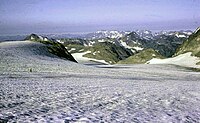
Photo from wikipedia
Abstract The artificial reduction of glacier melt is gaining increased attention due to accelerated ice wastage with atmospheric warming. In Switzerland, active coverage of glaciers using geotextiles is performed at… Click to show full abstract
Abstract The artificial reduction of glacier melt is gaining increased attention due to accelerated ice wastage with atmospheric warming. In Switzerland, active coverage of glaciers using geotextiles is performed at currently nine sites and since up to 15 years. The measures represent an efficient method to locally safeguard the operability of ski slopes or other touristic attractions. Here, we present an assessment of the evolution of geotextile-covered areas and the correspondingly avoided ice melt across the Swiss Alps. Presently, about 0.18 km2, or 0.02% of the total Swiss glacier area, is covered by geotextiles, with a doubling of the covered area since 2012. Up to 350,000 m3 of ice melt per year have been mitigated by this technique. We estimate the overall costs of active glacier melt reduction, and compute the price of 1 m3 of saved glacier ice, a number relevant for planning such measures. Average costs over the last decade range from 0.6 to 7.9 CHF m−3 yr−1 depending on the type of installation and its location on the glacier. These relatively high costs are an indication for the considerable economic value attributed to glacier ice. We also show that artificial melt reduction is not scalable. Whilst local interventions can be efficient and profitable, a hypothetical application to the larger scale shows that saving Alpine glaciers by technological solutions is neither achievable nor affordable.
Journal Title: Cold Regions Science and Technology
Year Published: 2021
Link to full text (if available)
Share on Social Media: Sign Up to like & get
recommendations!